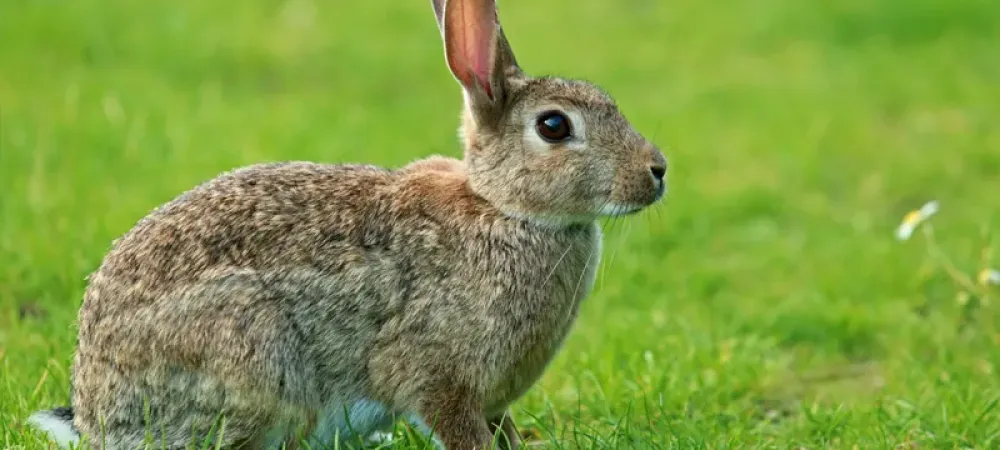What Do Wild Rabbits Eat?

It's nearly impossible not to marvel at the wonders of wild rabbits. With their playful antics and boundless curiosity, these fuzzy creatures captivate us with their mysterious ways—but have you ever stopped to wonder what wild rabbits eat?
This blog will explore the diets of wild rabbits, from what they naturally crave in different regions and climates to how human presence can affect the food they enjoy. Get ready to learn something new about our beloved wild rabbits!
But first, let's clear up a common misconception - there's a difference between a bunny and a rabbit. A bunny is a young rabbit, just like a baby is a human. So, when we say "wild rabbit," we're referring to adult hares, not cute little bunnies.
Got it? Good.
The Basics of Wild Rabbit Diets
Did you know that wild rabbits aren't picky eaters? Not only do they chow down on a variety of plants, but wild rabbits also love eating their own feces! Yep – it's true! But don't worry, this doesn't make them sick. In fact, it helps them to digest their food better!
When it comes to plant-based diets for wild rabbits, there are several common foods that these floppy-eared critters like to gobble up. Clover, dandelions and grasses are some of the most popular leafy greens on the menu. During wintertime when plant food is scarce, wild rabbits have been known to nibble on the bark and twigs of trees as well.
Now let’s talk about what not to feed wild rabbits. While store-bought rabbit food might be convenient, avoid feeding your furry friend anything with artificial preservatives or additives. These can cause your sweet bunny tummy upset! A much healthier alternative is to feed your wild rabbit fresh vegetables like kale or cabbage as well as small amounts of certain fruits every now and then (like strawberries!).
Finally, never forget the importance of providing your furry friend with a steady source of water. Wild rabbits need plenty of H2O in order to stay hydrated — especially during hot summer days!
Different Habits for Different Types of Rabbits
It's no secret that rabbits enjoy carrots, but did you know that their dietary habits actually differ depending on where they live? That's right – the type of habitat a rabbit lives in can influence what they eat and how they go about finding it.
Rabbits living in urban or suburban areas tend to have more access to humans and human-provided food sources. This means that if you spot a rabbit in your backyard or park, chances are they will make themselves right at home with your leftover cereal or pet food.
On the other hand, rural rabbits have to get a little bit craftier with their meals as human-provided food sources are usually scarce. The most common food source for them is vegetation such as clover, dandelions, grasses and wildflowers which provide them with essential nutrients like vitamins A and C.
Climate also plays an important role in determining what rabbits eat - during the winter months many plants become dormant and flowering vegetation may not be available for rabbits to munch on; therefore, some clever critters turn to bark from trees as an alternative source of nutrition!
It’s also not uncommon for hungry rabbits in colder climates to raid gardens looking for fresh vegetables during the winter months when natural vegetation is scarce.
The Importance of Variety
The importance of variety in wild rabbit diets is a topic often overlooked, but it’s essential to their health and well-being. Wild rabbits have an incredibly varied diet that helps them get the nutrients they need to survive, and without it they can become malnourished or even sick.
Wild rabbits are naturally drawn to grasses and other green vegetation, but they also love roots, flowers, clovers, fruits, fungi, nuts, seeds, bark and twigs. It’s important for them to eat a wide variety of these things in order to get all the vitamins and minerals that their bodies need.
Unfortunately not all wild rabbits rely on such a diverse diet. Many are content with eating just one type of food - usually lawn grass - which can lead to serious nutritional deficiencies over time. We recently heard a hilarious story about one such wild rabbit who was caught eating a houseplant! The homeowner didn't see the funny side though; he quickly “rabbit-napped” the little guy before he could cause any more damage!
But joking aside, if wild rabbits don’t have access to a wide variety of food sources they won't get enough of the essential vitamins and minerals they need. This can lead to deficiencies that can have serious effects on their health over time; including weakened immune systems and reduced fertility rates. Fortunately this is easily avoidable by providing them with plenty of different kinds of food sources in their local habitat.
Providing wild rabbits with foods like clover leaves or berries makes sure that they're getting all the nutrients they require for good health; while giving them access to fresh drinking water is also beneficial for helping them stay hydrated during hot summer months.
Additionally there are other simple steps you can take like planting an array of vegetation around your property or setting up feeders where you know rabbits are frequenting - both will make sure these furry creatures stay happy and healthy!
How to Provide a Nutritious Diet for Wild Rabbits in Your Garden
Are you looking to make your backyard a wild rabbit buffet? Well, with the right guidance and information, you can easily provide a nutritious diet for these little critters. But before we get into what wild rabbits can eat, let me tell you a story…
I was once living in an apartment when I noticed a sudden influx of wild rabbits in the garden. After doing some research, I discovered that the area was full of delicious plants and shrubs that they loved to munch on - providing them with all the nutrition they needed. As I watched them happily hopping around, I couldn't help but feel jealous of their natural diet!
So if you’re hoping to do the same for your wild rabbit family, here are some tips: Plant a variety of plants – like clover, dandelion greens, kale, oats and rye grass – to offer them some delicious greens.
Also make sure there is always fresh water available for them to stay hydrated. When it comes to what not to feed wild rabbits, human food such as bread and crackers should be avoided at all costs as these items lack the nutrients necessary for proper growth and development.
However – don’t worry! You can still give these little guys something extra special from time to time. If you want to really make your wild rabbit friends happy then why not try offering them dried fruits or veggies? Not only will this add some variety to their diet but it will also give them vitamins and minerals that they wouldn’t normally get from their regular fare.
Just remember – moderation is key! Too much dried fruit or vegetables could potentially cause digestive issues so it’s best not to overdo it.
The last thing worth mentioning is that while providing a nutritious diet is essential, having enough space for them is just as important. Because after all who doesn’t need room for all those crazy jumps and hops? So make sure there are plenty of open areas (preferably sheltered) where they can run around freely without any disturbances.
Now that we have covered what wild rabbits should eat, let me leave you with one final tip: Enjoy every moment with these adorable creatures as watching them enjoy their meals is truly a magical experience!
Q: How long do wild rabbits live?
A: Wild rabbits typically live for around 3-4 years.
Q: Can you keep a wild rabbit as a pet?
A: It is not recommended to keep a wild rabbit as a pet. Wild rabbits are not domesticated and may not be suitable for captivity. They have specific needs, behaviors, and dietary requirements that may not be met in a domestic setting. Additionally, it is illegal in many areas to capture or keep wild animals as pets. It is best to adopt a domestic rabbit from a reputable rescue or breeder.
Q: How to keep rabbits out of garden?
A: One way to keep rabbits out of a garden is to create a physical barrier, such as a fence, around the garden area. The fence should be at least 2 feet tall and buried at least 6 inches into the ground to prevent rabbits from digging under it. Another option is to use rabbit repellent sprays or granules, which emit a scent that rabbits find unpleasant. Additionally, planting rabbit-resistant plants in the garden and keeping the area clean and free of debris can also deter rabbits from entering the garden.
Q: What is a group of rabbits called?
A: A group of rabbits is called a colony or a warren.
Wrap Up!
Bringing things back full circle, it's amazing to look at how much wild rabbits eat, from plants and fruits to insects and small animals. No matter the environment or climate, these furry little critters are always adapting to their surroundings in order to get the nourishment they need.
Plus, you can now rest assured that if you ever spot a wild rabbit hopping around your neighborhood, you know exactly what its diet is! That’s one less thing for us humans to worry about. So don’t forget - wild rabbits eat a bit of everything! If rabbits are causing damage to your property, call Whitmore for professional rabbit removal today! You can save today using one of our coupons:


